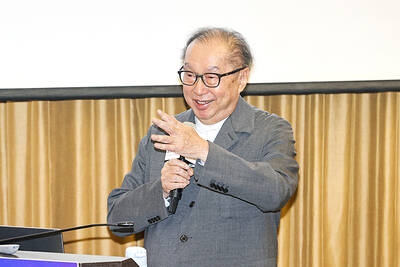Powerchip Semiconductor Corp (力晶半導體), the nation’s biggest manufacturer of computer memory chips, expects chip prices to rebound in June from almost a year-long overcapacity-driven slump as customer inventories fall, a company executive said yesterday.
Powerchip’s comments came in the wake of comments by its bigger rivals, including Japan’s top memory chipmaker Elpida Memory Inc and South Korea’s Samsung Electronics Co, of their intention to raise prices this month.
“We hope an uptick in contract prices will somehow help boost spot prices in April,” Powerchip president Brian Shieh (謝再居) told reporters on the sidelines of a groundbreaking ceremony for two new advanced 12-inch (300mm) plants in Hsinchu.
Shieh remained cautious, however, saying: “There is a better opportunity for prices to rise in the second half, probably in June, as [inventories] should fall [to a normal level] after a six-to-nine-month digestion.”
If not, most dynamic random access memory (DRAM) makers might not be able to survive this downturn, Shieh said.
Powerchip sells a major portion of its computer memory chips, specifically DRAM chips, on the spot market rather than to computer vendors, who buy DRAM chips from suppliers on contract basis via negotiations twice a month.
Taipei-based market researcher DRAMeXchange Technology Inc (集邦科技) said yesterday that DRAM spot prices had hit the bottom and might rebound gradually in the next few months as prices had approached or even dropped below cost over the past year, putting most suppliers under heavy financial pressure.
Next year might be a better period for DRAM makers in light of slower capacity expansion, estimated at a healthy 50 percent annual pace, Shieh said.
Powerchip aims to increase capacity by 55 percent to 60 percent year-on-year next year, mainly from Rexchip Electronics Co (瑞晶), a DRAM venture with Elpida, compared with a 65 percent expansion this year, Shieh said.
To meet future demand, the company plans to spend NT$250 billion (US$7.8billion) to build two new 12-inch plants in Hsinchu, with a combined capacity of 120,000 wafers a month.
The plants are scheduled to ramp up production in the fourth quarter of next year with an initial output of 20,000 to 30,000 wafers per month. Powerchip plans to make DRAM chips and NAND flash products at the factories using next-generation 50-nanometer technology.
Powerchip currently operates three 12-inch plants after spinning off a less advanced 8-inch (200mm) plant to form a liquid-crystal-display (LCD) driver IC venture, Maxchip Semiconductor Corp (鉅晶電子), with Japan’s Renesas Technology Corp and Sharp Corp.
Shares of Powerchip declined 2.2 percent to NT$11.35, while rival Nanya Technology Inc’s (南亞科技) fell 2.4 percent to NT$18.35, underperforming the TAIEX, which slid 0.65 percent yesterday.

BYPASSING CHINA TARIFFS: In the first five months of this year, Foxconn sent US$4.4bn of iPhones to the US from India, compared with US$3.7bn in the whole of last year Nearly all the iPhones exported by Foxconn Technology Group (富士康科技集團) from India went to the US between March and last month, customs data showed, far above last year’s average of 50 percent and a clear sign of Apple Inc’s efforts to bypass high US tariffs imposed on China. The numbers, being reported by Reuters for the first time, show that Apple has realigned its India exports to almost exclusively serve the US market, when previously the devices were more widely distributed to nations including the Netherlands and the Czech Republic. During March to last month, Foxconn, known as Hon Hai Precision Industry

Taiwan Semiconductor Manufacturing Co (TSMC, 台積電) and the University of Tokyo (UTokyo) yesterday announced the launch of the TSMC-UTokyo Lab to promote advanced semiconductor research, education and talent development. The lab is TSMC’s first laboratory collaboration with a university outside Taiwan, the company said in a statement. The lab would leverage “the extensive knowledge, experience, and creativity” of both institutions, the company said. It is located in the Asano Section of UTokyo’s Hongo, Tokyo, campus and would be managed by UTokyo faculty, guided by directors from UTokyo and TSMC, the company said. TSMC began working with UTokyo in 2019, resulting in 21 research projects,

Ashton Hall’s morning routine involves dunking his head in iced Saratoga Spring Water. For the company that sells the bottled water — Hall’s brand of choice for drinking, brushing his teeth and submerging himself — that is fantastic news. “We’re so thankful to this incredible fitness influencer called Ashton Hall,” Saratoga owner Primo Brands Corp’s CEO Robbert Rietbroek said on an earnings call after Hall’s morning routine video went viral. “He really helped put our brand on the map.” Primo Brands, which was not affiliated with Hall when he made his video, is among the increasing number of companies benefiting from influencer

Quanta Computer Inc (廣達) chairman Barry Lam (林百里) yesterday expressed a downbeat view about the prospects of humanoid robots, given high manufacturing costs and a lack of target customers. Despite rising demand and high expectations for humanoid robots, high research-and-development costs and uncertain profitability remain major concerns, Lam told reporters following the company’s annual shareholders’ meeting in Taoyuan. “Since it seems a bit unworthy to use such high-cost robots to do household chores, I believe robots designed for specific purposes would be more valuable and present a better business opportunity,” Lam said Instead of investing in humanoid robots, Quanta has opted to invest